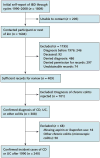Aspirin, nonsteroidal anti-inflammatory drug use, and risk for Crohn disease and ulcerative colitis: a cohort study
- PMID: 22393130
- PMCID: PMC3369539
- DOI: 10.7326/0003-4819-156-5-201203060-00007
Aspirin, nonsteroidal anti-inflammatory drug use, and risk for Crohn disease and ulcerative colitis: a cohort study
Abstract
Background: Aspirin and nonsteroidal anti-inflammatory drugs (NSAIDs) are anti-inflammatory but have been linked in some studies to Crohn disease (CD) and ulcerative colitis (UC).
Objective: To assess the association between aspirin and NSAID use and incident CD and UC.
Design: Prospective cohort study.
Setting: Nurses' Health Study I.
Patients: 76,795 U.S. women who provided biennially updated data about aspirin and NSAID use.
Measurements: Incident CD and UC between 1990 and 2008 (outcome) and NSAID and aspirin use (exposure).
Results: 123 incident cases of CD and 117 cases of UC occurred over 18 years and 1,295,317 person-years of follow-up. Compared with nonusers, women who used NSAIDs at least 15 days per month seemed to have increased risk for both CD (absolute difference in age-adjusted incidence, 6 cases per 100,000 person-years [95% CI, 0 to 13]; multivariate hazard ratio, 1.59 [CI, 0.99 to 2.56]) and UC (absolute difference, 7 cases per 100,000 person-years [CI, 1 to 12]; multivariate hazard ratio, 1.87 [CI, 1.16 to 2.99]). Less frequent NSAID use was not clearly associated with risk for CD or UC, and there was no clear association between aspirin use and disease.
Limitations: Cohort participants were exclusively women, most of whom were white. Aspirin and NSAID use were self-reported.
Conclusion: Frequent use of NSAIDs but not aspirin seemed to be associated with increased absolute incidence of CD and UC. The findings have more mechanistic than clinical implications, because the absolute incidence of CD or UC associated with NSAIDs was low and the increase in risk for CD or UC associated with NSAIDs is unlikely to alter the balance of more common and clinically significant risks and benefits associated with these agents.
Primary funding source: American Gastroenterological Association, IBD Working Group, Broad Medical Research Program, and National Institutes of Health.
Conflict of interest statement
Figures
References
-
- Musumba C, Pritchard DM, Pirmohamed M. Review article: cellular and molecular mechanisms of NSAID-induced peptic ulcers. Aliment Pharmacol Ther. 2009;30:517–31. - PubMed
-
- Singh S, Graff LA, Bernstein CN. Do NSAIDs, antibiotics, infections, or stress trigger flares in IBD? Am J Gastroenterol. 2009;104:1298–313. - PubMed
-
- Takeuchi K, Smale S, Premchand P, Maiden L, Sherwood R, Thjodleifsson B, et al. Prevalence and mechanism of nonsteroidal anti-inflammatory drug-induced clinical relapse in patients with inflammatory bowel disease. Clin Gastroenterol Hepatol. 2006;4:196–202. - PubMed
Publication types
MeSH terms
Substances
Grants and funding
LinkOut - more resources
Full Text Sources
Other Literature Sources
Medical


